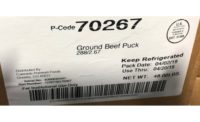Source: Food Safety News
Starting the development of guidelines to control Shiga toxin-producing Escherichia coli (STEC) in certain foods was one of the decisions made by the Codex Alimentarius Commission at its annual meeting in Geneva this week.
The work will cover STEC in beef, leafy greens, raw milk and cheese produced from it, and sprouts. It could take up to 5 years to complete the project.
Codex Alimentarius was created by the Food and Agriculture Organization of the United Nations (FAO) and the World Health Organization (WHO).
The Codex Committee on Food Hygiene (CCFH) will develop the guidelines to support risk management for STEC in the designated products. The CCFH started discussing STEC in foods in November 2013.
Guidelines should provide a framework for countries to establish control measures appropriate to their national situations, according to information from the organization. The guidelines will not set quantitative limits for STEC in any of the products.
Control measures for primary production, processing and distribution channels, validation, verification, monitoring and review of the measures and laboratory analysis detection criteria for control of STEC in food using virulence factors will be covered by the guidelines.
JEMRA and FERG Foundation
STEC control poses an economic impact in terms of disease prevention and treatment and has implications for domestic and international trade with the potential to become a risk management priority in countries where it is not currently considered a public health issue.
A joint FAO/WHO Expert Meetings on Microbiological Risk Assessment (JEMRA) panel published a report on STEC in June 2018. The pathogens are a significant cause of foodborne diseases. Infections from E. coli have been associated with a spectrum of human illnesses ranging from mild infections with non-bloody diarrhea to bloody diarrhea and the life-threatening complication of hemolytic uremic syndrome, which is a type of kidney failure.
Main sources of STEC are estimated to be fresh produce, beef and dairy products. More than half of the outbreaks globally could not be attributed to a specific source, according to JEMRA.
The Foodborne Disease Burden Epidemiology Reference Group (FERG) has estimated foodborne STEC caused 1 million illnesses and more than 100 deaths in 2010.
STEC is the only remaining foodborne hazard considered by FERG for which risk management guidance has not been developed by Codex.
Aflatoxins, e-Commerce, and Pesticide MRLs
Attendees also agreed to establish maximum levels for aflatoxins in certain cereals and cereal-based products in the hope of reducing dietary exposure to this mycotoxin.
The work will focus on creating maximum levels for corn destined for further processing and flour, meal, semolina, and flakes derived from corn; husked and polished rice; cereal-based food for infants and young children; and sorghum. Maximum levels will be finalized in 2022 at the latest.
The Codex Alimentarius Commission agreed to do new work on the labeling of food sold through internet sales and e-commerce. The United Kingdom introduced this item on behalf of co-drafters Chile, Ghana, India, and Japan.
There is a lack of standardized guidance for the labeling of food sold via internet sales and e-commerce which raises issues about health, food safety, and protection of fair practices in food trade, according to the drafters.
While some countries have adopted regulations related to e-commerce, its growth means consistency needs to be maintained at a global level to ensure consumers are protected and impediments to trade from different approaches are minimized, according to health officials.
There was also agreement on draft guidelines for rapid risk analysis when contaminants of food are detected and there aren’t any regulatory levels. This problem is increasing because of diversity of the food supply and continuing advancement of analytical capabilities. Risk managers protect public health as well as considering trade, according to officials.
Examples of contaminants covered by the guidelines are those that may occur in materials used or created during the processing of food and that might be inadvertently present. Those include printing inks; oils/lubricants/resins used as manufacturing maintenance compounds; cleaning compounds; and traces of chemicals used in the factories.
The Codex Alimentarius Commission adopted maximum residue limits for more than 30 different pesticides in foods including crops such as barley, rye, and rice; vegetables like garlic, cucumber, and peas; fruits such as bananas, oranges, and grapes; and animal products like milk, eggs, and poultry.
Maximum limits ensure pesticide residues do not harm health, according to officials, and are based on risk assessments from the Joint FAO/WHO Expert Meeting on Pesticide Residues.






